Exploring the Mythos of Bahamut: A Comprehensive Examination
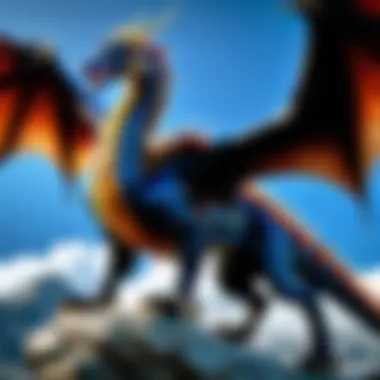
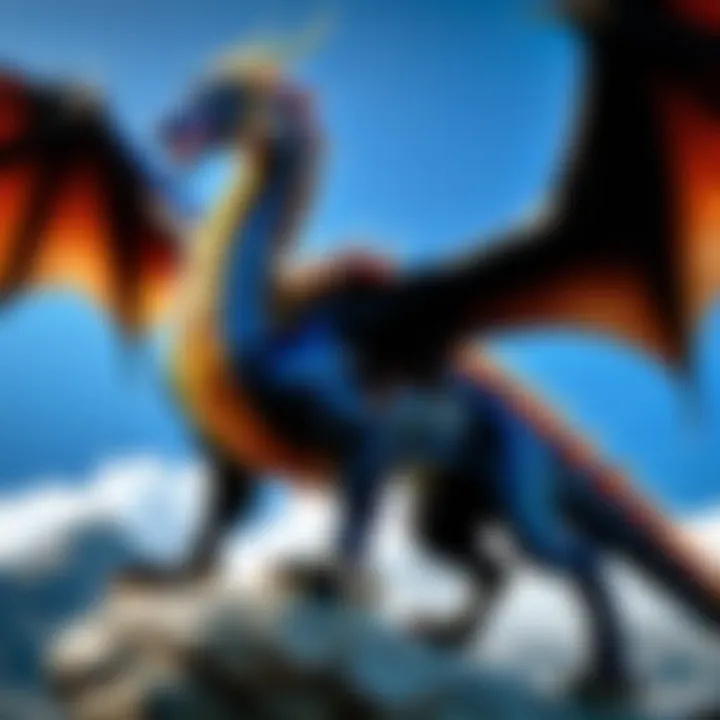
Intro
The figure of Bahamut stands as a compelling presence across various strata of culture, mythology, and gaming. Originating from ancient texts, Bahamut has transcended his initial depictions to become a symbol of strength and nobility in many modern narratives. His characteristics have evolved, influencing how he is perceived in contemporary media such as anime and gaming. This examination aims to unpack those various interpretations, offering a nuanced view of Bahamut’s considerable impact on storytelling.
Character Profiles
Overview of Main Characters
In exploring the mythos of Bahamut, one cannot overlook the central characters that surround him in these narratives. Often portrayed as a dragon or a deity, his main representation emerges from the Dungeons & Dragons franchise, where he is referred to as the Platinum Dragon. This iteration builds on his image as a guardian of justice and honor. Other significant figures include Tiamat, his counterpart in many mythological contexts, representing chaos and greed. Their dynamic creates a rich tension that is often explored in storytelling.
In various anime series, Bahamut may appear as both protagonist and antagonist. For instance, in the anime "Rage of Bahamut: Genesis", his essence is illustrated through epic clashes and moral dilemmas, intertwining him deeply with the narrative thread.
Supporting Characters
The supporting cast that complements Bahamut's narrative serves to amplify his significance. Characters like the adventurer, the fallen angel, and the common folk contribute diverse perspectives. Their experiences and conflicts create a multi-faceted storytelling environment. They reflect society's view towards deities and dragons, shaping Bahamut's influence on their lives.
Theme Exploration
Central Themes
The narratives involving Bahamut frequently draw on themes of justice, morality, and the battle between good and evil. His character often acts as a benchmark for righteousness. The dichotomy between Bahamut and Tiamat encapsulates the eternal struggle for balance within the universe. These themes resonate with audiences, reflecting their own moral landscapes.
Cultural References
Bahamut's impact can be traced through various cultural references. In Islamic mythology, Bahamut is considered a cosmic fish that supports the earth. This original portrayal illustrates his longevity and adaptability across cultures. Modern adaptations in video games and anime draw inspiration from these traditional roots while re-defining his image for contemporary audiences.
Popular Series and Recommendations
Top Anime Series of the Year
Several anime series stand out in their portrayal of Bahamut and related themes. Works like "Fate/Grand Order" and "Berserk" incorporate elements that embody the essence of Bahamut’s narrative significance. These shows provide both thrilling action and profound ethical questions.
Hidden Gems in Manga
For those diving deeper, exploring manga such as "The Seven Deadly Sins" reveals fascinating interpretations of similar mythical figures. Titles like "Vinland Saga" also reflect the broader human experience with mythology, enhancing the relevance of Bahamut's archetype in modern storytelling.
"Bahamut's evolution from ancient myth to modern lore exemplifies how storytelling adapts and resonates with contemporary audiences."
Incorporating these insights allows for a richer understanding of Bahamut's role in narrative frameworks. As this examination continues, it aims to unravel the complexities of his character, showcasing his relevance in a multifaceted landscape.
Prelude to Bahamut
The figure of Bahamut serves as a vital touchstone in both mythological discussions and contemporary narratives. His dual nature as a symbol of power and protector evokes a wide range of interpretations. Understanding Bahamut's character offers insights into not only antiquated texts but also modern storytelling devices. In this article, we aim to dissect the layers of Bahamut’s mythos, analyzing his significance across different cultures and media.
Defining Bahamut
Bahamut, often depicted as a massive dragon-like creature, has origins that can be traced back to ancient mythological texts. He is commonly recognized as a figure representing strength and authority. In various traditions, Bahamut is often associated with water and the cosmic elements. Historically, he is portrayed as a primordial entity, bearing great responsibility in overseeing the balance of the universe.
While he predominantly features in Islamic mythology, his representation has expanded significantly in contemporary culture, particularly in role-playing games like Dungeons & Dragons. The multifaceted nature of Bahamut makes it essential to define his character comprehensively, focusing on both his foundational myths and adaptations in modern narratives.
Cultural Significance
The cultural importance of Bahamut cannot be overstated. He embodies concepts of justice, virtue, and divine power, often symbolizing the battle between good and evil. His character resonates in various forms including literature, gaming, and anime, providing a common thread linking ancient stories with modern interpretations.
In gaming contexts, particularly in Dungeons & Dragons, Bahamut is revered as the deity of justice and protection. His embodiment as a benevolent force has influenced players' experiences, allowing for exploration of moral choices within fantasy realms.
His portrayal in anime and manga frequently aligns with themes of guardianship, illustrating a protective spirit that has captured the imagination of many. Thus, exploring the cultural significance of Bahamut not only aids in understanding his narrative roles but also fosters a deeper appreciation for the values he represents within diverse settings.
Origins of Bahamut
The origins of Bahamut are crucial for understanding his character and significance in various narratives. This section uncovers his roots, both in historical texts and mythology, providing context for how Bahamut has evolved. Recognizing the precursors to his legend allows one to grasp the multifaceted nature of his representation today. Various elements contribute to the character's depth, making it vital to examine both pre-Islamic myths and subsequent Islamic texts.


Pre-Islamic Myths
In pre-Islamic mythology, Bahamut can often be found in ancient Arab folklore and cosmology. The creature is depicted as a massive fish or whale that supports the Earth on its back. This imagery introduces the notion of foundation and stability in a chaotic universe. Bahamut was said to be an essential figure upholding the world, which reflects cultural values regarding strength and sustenance.
There are multiple tales that introduce Bahamut, linking him with the creation and structure of the universe. The deeper meanings in these stories often resonate with themes of power and order. Such myths inform later interpretations and indicate the character's significance in the broader scope of mythology.
Islamic Texts
In Islamic texts, particularly in the Quran and various hadiths, Bahamut gains a more defined shape and role. There, it is described as a creature that carries the Earth, but it also serves as an agent of divine will. The narrative impacts how Bahamut is viewed in a spiritual sense, illustrating concepts of guardianship and responsibility alongside mere physical support.
The works of medieval scholars and commentators often mention Bahamut within the context of cosmology, where it held a place among other creatures in the universe. This portrayal emphasizes the importance of Bahamut in sustaining not just the Earth but the spiritual order as well.
"Bahamut, in its essence, represents the intersection of physical power and divine authority."
The transition from pre-Islamic myths to Islamic texts illustrates how Bahamut has been shaped by historical and cultural forces over time. Understanding these origins enriches the modern interpretations found in media and storytelling, offering insights into how deeply ingrained these mythos can be in various cultures.
As we proceed through this article, delving into various portrayals of Bahamut in contemporary settings, the foundational understanding of his origins will provide necessary context for the relevance he holds in popular culture and narratives today.
Bahamut in Western Media
Bahamut's presence in Western media is both significant and multifaceted. His adaptation and interpretation stretch across various formats, from tabletop role-playing games to video games and beyond. The significance of his incorporation into Western narratives cannot be understated. It reflects a growing interest in mythological figures and their roles in storytelling that resonates strongly with audiences. As media evolves, so too does the representation of characters like Bahamut, directly shaping the gaming experience and influencing narrative arcs. Understanding Bahamut's role in this context allows for a deeper appreciation of how mythology informs modern storytelling.
Role in Dungeons & Dragons
In the realm of tabletop games, particularly Dungeons & Dragons, Bahamut occupies a special status. Often referred to as the Platinum Dragon, he represents justice, protection, and honor. This character exemplifies the concept of a benevolent deity, influencing the moral compass of players as they navigate complex scenarios. In Dungeons & Dragons, Bahamut is characterized as the god of good-aligned dragons, and his followers seek to spread his ideals.
His influence manifests through various mechanics and lore present in the game:
- Deity of Good Dragons: Players can engage with Bahamut's teachings by choosing classes or alignments that reflect his values.
- Spells and Abilities: Many spells and character abilities draw upon Bahamut's essence, encouraging gameplay that emphasizes teamwork and altruism.
- Narrative Hooks: Campaigns often incorporate quests or conflicts that revolve around Bahamut, driving characters to make moral decisions and fostering dynamic storytelling.
Thus, Bahamut in Dungeons & Dragons is more than a mere character; he serves as a foundational pillar for players' experiences, embodying themes of justice and heroism.
Influence on Video Games
Video games have also drawn heavily from Bahamut’s mythos, with numerous titles featuring him or his ideals in various ways. His appearances span a broad spectrum of genres, indicating his versatility as a character. Some notable aspects of his influence include:
- Final Fantasy Series: One of the most well-known portrayals of Bahamut occurs in the Final Fantasy games, where he often appears as a powerful summon. His design, abilities, and narrative connections elevate him beyond a simple game element, anchoring gameplay in traditional mythological themes.
- World of Warcraft: Bahamut has also made his mark in large-scale online environments like World of Warcraft. His character influences in-game lore and quests, allowing players to explore his commitment to justice and righteousness in a communal setting.
- Mobile and Indie Games: Lesser-known games have adopted elements of Bahamut's character as well, showcasing his adaptability as a symbol of power and protection.
In summary, Bahamut's influence in video games enriches the gaming landscape, inviting players to engage with themes drawn from mythology while inviting discussions about morality and heroism in virtual realms.
Bahamut in Anime and Manga
Bahamut's presence in anime and manga is significant, shaping narratives and character development in modern storytelling. Often portrayed as a majestic dragon or a powerful deity, Bahamut resonates with audiences through his richness in symbolism and depth. His portrayal in these media does not merely borrow from traditional mythology, but rather adapts to reflect contemporary themes and ideals.
Character Portrayals
In anime and manga, Bahamut is frequently depicted as a noble figure, representing harmony and righteousness. Many creators interpret him through varying lenses—some present him as a savior, while others explore his more complex aspects. Characters inspired by Bahamut often embody traits such as wisdom, strength, and a sense of justice. A notable example is the anime "Rage of Bahamut: Genesis," where the character Bahamut is central to the plot, embodying both destruction and salvation.
Moreover, there is a trend where characters affiliated with him undergo significant development. Through their interactions with Bahamut, they confront their own morals and beliefs. This dynamic provides viewers and readers with a deeper understanding of the struggle between good and evil. The reflections upon Bahamut lead to character arcs that often explore redemption and personal growth.
"In each portrayal, Bahamut remains a figure that challenges characters to rise beyond their initial circumstances."
Thematic Representations
Thematically, Bahamut is often linked to grand narratives that revolve around the conflict between light and darkness. His representation serves as a narrative device that drives the conflicts in the story. These battles can manifest as external confrontations or internal dilemmas faced by characters in their journey.
Additionally, the idea of guardianship emerges in many stories featuring Bahamut. He symbolizes protection, guiding both characters and audiences through tumultuous events. Further, these themes resonate deeply with genres such as fantasy and adventure, which are staples in anime and manga. The inherent desire for protection and strength in Bahamut's character allows viewers to connect with him on a personal level.
The adaptation of Bahamut in these forms also speaks to evolving cultural narratives. As societies change, so too do the interpretations of mythological figures. Where Bahamut once might have been a fearsome entity in ancient texts, he is now a complex character, frequently evoking empathy and admiration. This shift not only entertains but also invites thoughtful discourse regarding moral responsibility and existential questions.
Through these portrayals and representations, Bahamut serves as more than a figure from myth. He becomes a symbol of ideals, a catalyst for character development, and a mirror reflecting societal values, ultimately enriching the narrative landscape of anime and manga.
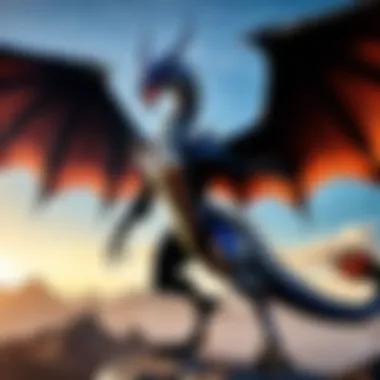
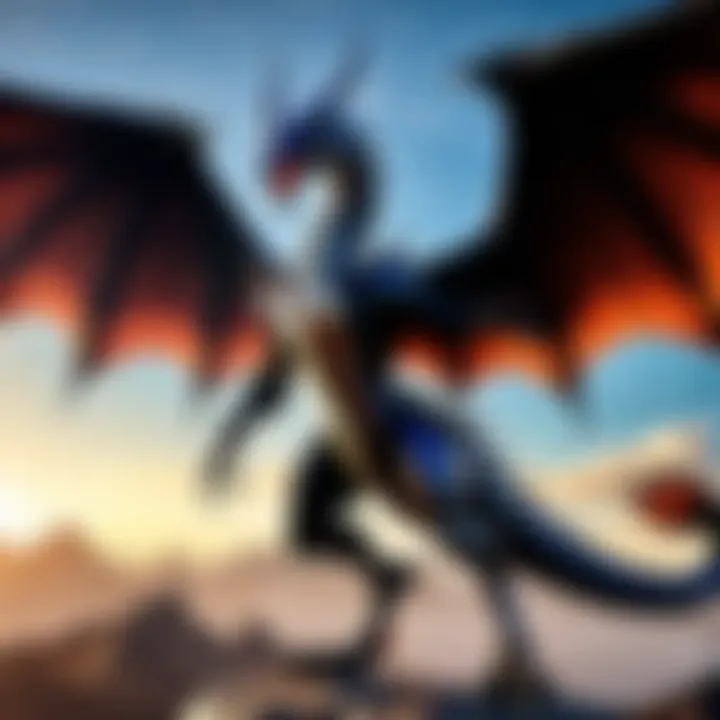
Bahamut's Symbolism
Bahamut serves as a pivotal symbol within various mythologies, gaming narratives, and pop culture. His representation combines elements of power and guardianship that resonate with diverse audiences. This section will explore how Bahamut's symbolism contributes significantly to the themes of strength and protection in storytelling. Understanding these symbolic layers enhances our appreciation of the character's role across media. It reminds us that Bahamut is not just a mythical creature; he embodies core values that permeate narratives.
The Representation of Power
Bahamut is often depicted as an embodiment of immense power. In many narratives, he is referenced as a dragon with authority and dominion over lesser beings. This power is not merely physical; it also represents a moral strength. In games like Dungeons & Dragons, Bahamut is called the Platinum Dragon, associated with law, justice, and the fight against evil. His followers often seek to channel this power in their own lives, upholding a noble code. The representation encapsulates both physical might and ethical responsibility, illustrating that true power originates from moral integrity.
"Bahamut represents more than just physical might; he symbolizes a steadfast commitment to justice and righteousness."
Moreover, Bahamut's power resonates in various cultures. In Islamic texts, he is often connected with cosmic balance and the control of chaos. His capacity to maintain harmony within the universe reflects a deeper philosophical understanding of power as a force that should be regulated and guided. This perspective on Bahamut allows for a multifaceted interpretation of authority, mirroring contemporary societal discussions regarding power and its ethical implications.
The Guardian Archetype
In addition to representing power, Bahamut epitomizes the guardian archetype. This aspect is cultivated through his portrayal as a protector of the weak and a champion of justice. In many stories, he is a figure of salvation, embodying benevolence alongside strength. Bahamut's role as a guardian enhances his character, making him relatable and admirable to those who encounter him.
The guardian symbolism manifests differently across various media. In video games, Bahamut often serves as a guiding figure for players, offering protection and wisdom. He is a source of strength in challenging situations, embodying the idea that one can wield power responsibly for the benefit of others.
In anime and manga, this archetype is also present. Characters influenced by Bahamut often reflect his values of courage, loyalty, and the defense of justice. This archetypal representation fosters a sense of hope and reassurance for audiences, drawing them into the narrative and inspiring them to emulate these qualities in their own lives.
Bahamut’s symbolism, therefore, acts as a bridge between fiction and real-world values. His character serves as a reminder that power can and should be used to protect and uplift, reinforcing the ideals of guardianship within various storytelling frameworks.
Modern Interpretations of Bahamut
Modern interpretations of Bahamut exhibit a dynamic evolution of this mythical figure, bridging ancient lore with contemporary narratives. Understanding how Bahamut is perceived today is crucial for grasping his relevance across various media. As society progresses and shifts in cultural contexts occur, so too does the interpretation of mythological figures like Bahamut, adapting to new audience sensibilities and themes prevalent in modern storytelling.
Through the lenses of gaming, anime, and other forms of popular culture, Bahamut acquires new meanings and associations. This transformation allows for a richer exploration of themes such as justice, power, and protection, which resonate with audiences. Furthermore, the diverse portrayals reflect the fluidity of myth in a globalized world, showcasing shared human experiences.
Shift in Perceptions
The perceptions of Bahamut have notably shifted over the years, influenced by societal changes and advancements in storytelling techniques. Initially represented as a solitary dragon or a cosmic being in mythological texts, recent interpretations expand his role significantly. No longer confined to traditional narratives, Bahamut now represents ideals of heroism and morality, making him relatable to contemporary audiences.
In many modern adaptations, Bahamut embodies a duality; he is both a fierce protector and a formidable opponent. This complexity deepens his character, allowing creators to explore themes such as loyalty and sacrifice. The ability to view Bahamut through various contexts encourages discussions about good versus evil, creating a platform for nuanced character studies that resonate with modern audiences.
Bahamut in Popular Culture
Bahamut's presence in popular culture continues to flourish, with notable appearances in video games, anime, and films. Many games, including Final Fantasy and Dungeons & Dragons, feature him as a powerful deity, often depicted as a majestic dragon representing the forces of law and good. In these contexts, Bahamut serves as both a guide and a challenge for players, emphasizing themes of choice and consequence.
In anime and manga, the character often takes on new forms, reflecting the diverse storytelling styles and audience expectations. Works such as Dragon Quest and Record of Grancrest War highlight Bahamut's role in fantastical worlds, emphasizing his influence on character journeys and overarching narratives.
"Bahamut's adaptability in modern storytelling allows for deeper conversations about morality and heroism, transcending simplistic character traits."
The representation of Bahamut is not limited only to heroics. He also appears as an antagonist or a misunderstood character in some stories, adding to the layers of interpretation. This duality enhances engagement and invites analysis from audiences, drawing them into a rich tapestry of mythology intertwined with contemporary issues.
Through the lens of modern media, Bahamut has indeed transformed into a multifaceted entity. This ongoing evolution reflects the ever-changing relationship between mythology and contemporary society, demonstrating how traditional narratives can adapt and find relevance in today’s world. The future holds further possibilities for Bahamut as new narratives continue to emerge, ensuring his lasting impact in popular culture.
Bahamut Across Cultures
Bahamut is a figure that transcends geographical boundaries and cultural narratives. His presence in various mythologies indicates a deeper significance attached to dragons and their symbolic roles. This section will explore the importance of the topic of Bahamut across cultures, shedding light on how diverse societies have interpreted this legendary figure. The examination encompasses specific elements, benefits, and considerations that highlight Bahamut's universal appeal.
Comparative Mythology
Comparative mythology serves as an essential lens through which to analyze the narratives surrounding Bahamut. In several cultures, dragons symbolize power, wisdom, and even chaos. For instance, in ancient Mesopotamian texts, the dragon-like creature is often depicted as a guardian of the universe, similar to Bahamut's overarching role in Islamic mythology.
However, Bahamut's interpretation is not limited to specific regions. In Hindu mythology, the concept of the 'Naga' reflects the themes of water and protection, similar to Bahamut's depictions as a guardian of the ocean. By comparing these narratives, one can see how the image of Bahamut aligns with, or diverges from, dragon lore in other civilizations.
"The essence of mythology lies in its adaptability across different cultures, illustrating universal truths through unique lenses."
Global Reception
The reception of Bahamut on a global scale highlights the character's ability to resonate with audiences far removed from his original cultural context. In modern media, Bahamut's image has evolved yet retains an elemental connection to its roots.
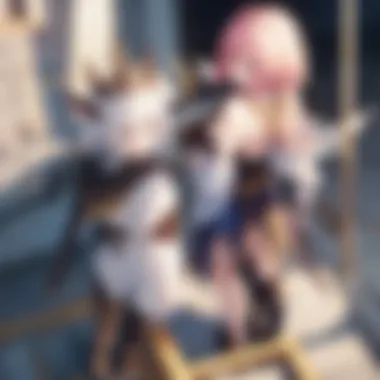
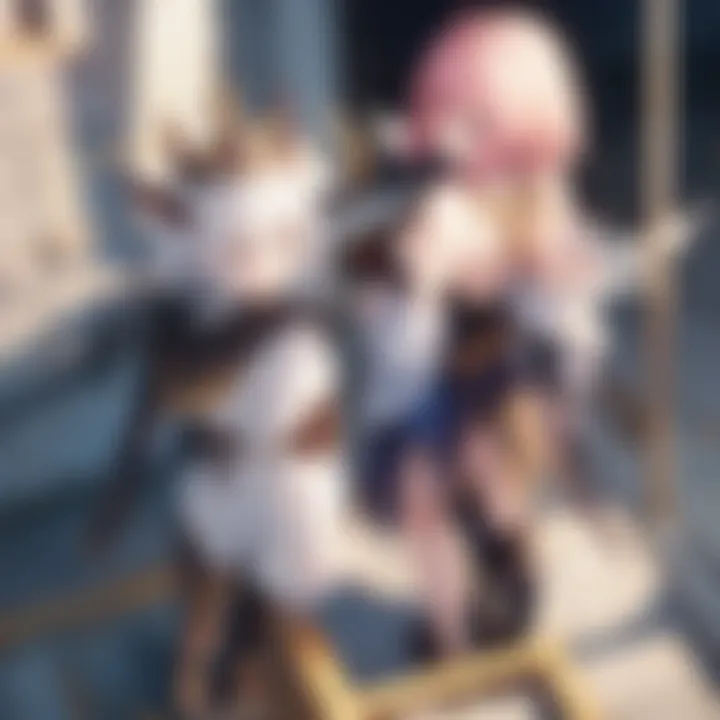
For instance, games like Final Fantasy have popularized Bahamut, portraying him as a powerful ally while maintaining ties to his mythological origins. Similarly, his appearances in anime showcase the character's versatility, adapting to various storylines and themes.
Examining the global reception involves considering factors like:
- Cultural Adaptation: How Bahamut has been reimagined in various mainstream media.
- Audience Engagement: The appeal of Bahamut's character to different demographics, particularly within the realms of gaming and storytelling.
- Cross-Cultural Symbolism: The underlying themes that persist regardless of cultural backdrop, such as guardianship and conflict.
Through these reflections, it becomes clear that Bahamut embodies potent cultural narratives, making him a valuable figure in the study of myth and its adaptations in modern storytelling.
Impact on Storytelling
The study of Bahamut’s influence in storytelling is essential for understanding how his character has developed and adapted over time. As a figure rooted in deep mythological heritage, Bahamut serves not just as a character but as a narrative device that shapes plots and themes across various media. Bahamut's presence in diverse narratives reflects broader cultural themes, allowing writers to explore complex ideas regarding power, morality, and redemption. This section will analyze key elements that illustrate Bahamut’s impact on storytelling.
Narrative Devices
Bahamut's character functions as a vital narrative device in many works. He often embodies archetypes that deepen the complexity of a story. His towering form symbolizes strength, justice, and protection. Authors utilize Bahamut to create a moral compass for protagonists, guiding them through their conflicts.
- Symbol of Justice: In various tales, Bahamut is the guardian of balance, representing the ideal of justice. This role can create tension in stories, where characters must confront ethical dilemmas, often having to choose between personal desires and the greater good.
- Catalyst for Change: When Bahamut appears, characters frequently find themselves challenged, prompting personal growth. This transformation can result from a trial, a quest for redemption, or the pursuit of a higher purpose.
- Conflict Resolution: Bahamut can serve as a solution to pressing conflicts in narratives. His involvement may bring resolution through intervention or by inspiring characters to change their ways.
Character Development
The portrayal of Bahamut influences character development significantly. The effect he has on main characters offers a pathway to explore their evolution throughout a narrative. Bahamut’s larger-than-life presence urges characters to confront their inner fears, beliefs, and motivations. Here are some ways this manifests:
- Internal Conflicts: Characters grappling with their identities often find clarity in Bahamut’s strength. The juxtaposition of their vulnerabilities against his grandeur provides a vivid contrast that can enhance dramatic tension.
- Allegiance Formation: Individuals who idolize or fear Bahamut may develop distinct motivations and alliances throughout a story. This dynamic can create complex relationships that reflect human emotions and aspirations.
- Archetypical Growth: Characters that interact with Bahamut often move from naive perspectives to realizing the necessity of responsibility and sacrifice. Their arcs evolve as they embrace these qualities, leading to richer narratives.
"Bahamut, as a guardian and a guide, challenges characters to be better versions of themselves, illustrating the transformative power of belief and aspiration."
The Future of Bahamut
The future of Bahamut presents a fascinating landscape for exploration as it intersects with evolving narratives and changing audience perceptions. This section probes into the topic's significance within the broader context of mythology and pop culture, offering insights into how Bahamut can adapt and thrive in modern storytelling. As interest in gaming and anime continues to grow, the character of Bahamut stands to gain new layers of complexity and relevance that resonate with contemporary themes and audience expectations.
Emerging Trends in Media
In recent years, significant trends have emerged across media, influencing how Bahamut is portrayed and understood. One notable trend is the blending of genres. For instance, fantasy and science fiction often converge in new storylines. Characters similar to Bahamut appear in anime that incorporate futuristic elements alongside mystical traditions. This creates fresh opportunities to reinterpret his archetype.
Another trend includes the rise of interactive storytelling. With video games gaining popularity, narratives involving Bahamut can become more immersive. Games like "Final Fantasy" have already demonstrated how player choices can directly influence the trajectory of Bahamut’s character. As technology advances, expect more sophisticated ways for audiences to engage with the mythos, perhaps through virtual reality experiences.
Also, the increasing focus on representation in storytelling gives Bahamut's character a chance for deeper narratives. By exploring his role beyond a mere symbol of power, creators can elevate narratives that discuss themes like duty, sacrifice, and moral ambiguity. Such depth can appeal to audiences seeking more than traditional portrayals, enhancing both his significance and the engagement factor.
Potential for New Narratives
The potential for new narratives surrounding Bahamut is vast. As societal values shift, the stories involving him can incorporate themes that reflect current social debates. For example, climate change and environmental issues can serve as a backdrop in future stories, portraying Bahamut not just as a powerful being but also as a guardian of the earth, forcing characters to confront their responsibilities toward their environment.
Furthermore, the duality of Bahamut's nature presents opportunities to explore internal conflicts. Such narratives could delve into his struggles between chaotic instincts and a desire to protect. Writers can take inspiration from his historical depictions while crafting new stories that challenge preconceived notions. This creates a multi-dimensional character who resonates on various emotional levels with audiences.
The rise of fan-driven content also plays a role in shaping new narratives. As communities on platforms like Reddit and Facebook discuss and analyze Bahamut, they may generate exciting interpretations that influence professional productions. Engagement from fans can drive creators to adopt new ideas, leading to innovative and diverse explorations of Bahamut’s character.
"The richness of mythology grants freedom for reinterpretation. Bahamut’s future lies in its ability to adapt and resonate with new generations."
End
The conclusion serves as a pivotal element in this article, encapsulating the core themes that have been explored throughout. It synthesizes the multifaceted depictions of Bahamut, revealing how the character shifts across cultures and media. In a detailed examination of narrative devices, the conclusion highlights the contributions Bahamut makes to storytelling. Additionally, it presents the relevance of Bahamut as an archetype in both mythological contexts and modern interpretations.
Summary of Findings
The findings of this article underline Bahamut’s evolution from ancient texts to contemporary storytelling. His symbolic representations, whether as a guardian or a figure of immense power, are central to understanding his impact. Key points include:
- Cultural Evolution: Bahamut’s journey from pre-Islamic myths to Islamic texts demonstrates adaptation over time.
- Influence on Media: His role in Dungeons & Dragons and various video games illustrates his significance in popular culture.
- Anime and Manga Representation: Diverse portrayals in anime and manga show how contemporary creators utilize Bahamut's attributes for character depth and thematic exploration.
Overall, Bahamut serves as a bridge between historical mythology and modern narratives, proving his lasting importance.
Final Thoughts
In reflecting on the inquiry into Bahamut's various representations, it becomes clear that this mythological figure transcends his original narratives. With the blending of ancient archetypes into new stories, the potential for developing fresh narratives centered around Bahamut remains vast.
As audiences seek deeper connections in media, characters like Bahamut will likely continue to inspire reimagining and reinterpretation. The exploration of his mythos not only satisfies an urge for knowledge but also enhances the storytelling landscape by integrating rich cultural lore with modern creativity.
"In understanding characters like Bahamut, we tap into a reservoir of mythological inspiration that continues to shape contemporary storytelling."
Whether one is a seasoned observer of anime and gaming or new to the material, the implications of Bahamut's character remain significant for ongoing cultural discourse.





